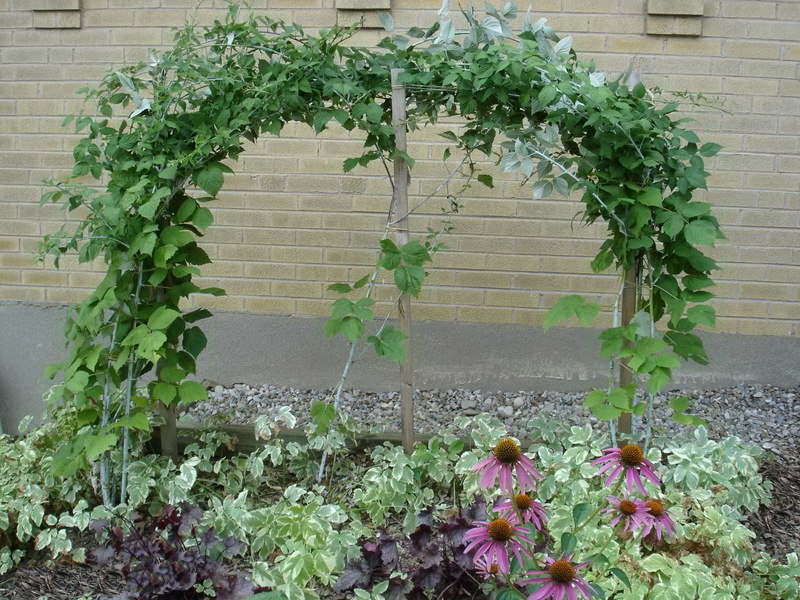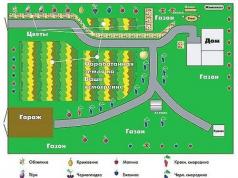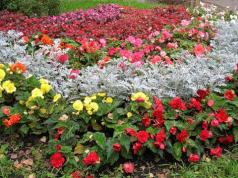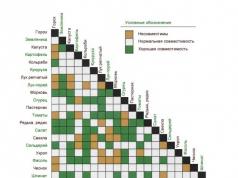What is a jellyfish? Already by the name you can determine that this is a combination of blackberries and raspberries. American breeders received this hybrid at the end of the 19th century. The results are pleasing: high yield, unpretentiousness and ease of care. For our area, culture is a novelty, it is not often seen in Russian dachas and household plots.
The hybrid received the best features from its "parents". Both berries have excellent taste qualities: the taste of blackberry is something in between, there is both sweetness and original sourness. As for the characteristics of the bush itself and care: the culture grows well even in the northern regions (an advantage inherited from raspberries), does not impose special requirements on the composition of the soil (“reward” from blackberries), the stems cover very small spines (unlike blackberries, large the thorns of which cause discomfort during harvesting).
So, on the raspberry plot, it eliminates the need to grow 2 berry plantations at once: raspberries and blackberries. This saves time and space on the site. High yields will allow you to stock up on fresh berries, make preparations for the winter (comotes, preserves, jams).
Ezhmalina has not yet received wide distribution. Well, if your neighbors have already acquired such a plant, you can ask for a seedling. Often seedlings are sold through sites on the Internet. But when buying, consider some subtleties: do not order goods from a company located thousands of kilometers away from you, because the climatic conditions there may be different. Also, the shorter the path the seedlings travel, the better they will survive and successfully take root. The best option is to buy in specialized centers or nurseries.
Reproduction of raspberries
Reproduction of raspberries involves several options:
basal processes

In early spring, carefully separate the shoot from the mother plant, immediately plant it in a permanent place of growth.
Rooting cuttings

In early spring, cut from last year's branches, in early summer - from young annual shoots, their length should be 30-35 cm and they should have several growth buds.

For rooting, plant in pots with nutritious soil, provide heat and regular. The roots will appear in about a month - plant them in a permanent place of growth so that the seedlings have time to get stronger before the cold weather.
layering

In August, bend a young strong branch to the ground and dig it into a trench to a depth of about 20 cm. In the spring, sprouts will appear (3-4 shoots can be obtained). They can be transplanted to a permanent place of growth when they get stronger (their height should be at least 15 cm).
Landing dates
Landing can be carried out in early spring (as soon as the ground has thawed and it has become possible to enter the site) or in autumn (October is the best time).
Plot for growing raspberries

To grow a raspberry plantation, choose a site that is well lit by sunlight and protected from drafts. Avoid the close occurrence of groundwater - you can make high beds.
Planting rules for blackberry
Spend single bushes or rows. In the first case, an individual support for each plant will be required, in the second case, you can shoot along the trellis.
The approximate size of the landing pit is 40x40x40 cm. You can make the hole smaller or larger - the main thing is that the root system should fit freely. Lay a drainage layer of coarse sand at the bottom, add a little rotted manure or compost.
- Place the seedling in the planting hole, straighten the roots, fill the rest of the space with soil taken out of the hole mixed with potassium-phosphorus fertilizer. If the soil is acidic, also add ash or dolomite flour.

- Keep a distance of about 1 m between individual plants, and 2 m between rows.
- Press the soil around the seedling a little, the root neck should be level with the soil surface.
- Cut the shoots, leaving a height of about 30 cm.
- To prevent the growth of weeds, cover the surface of the soil with cardboard (in a year it will rot and serve as fertilizer). Sprinkle any mulching material on top (a mixture of dry sawdust and ash is perfect), the layer thickness should be 8-15 cm.
For raspberries, it is better to install immediately during planting. For each individual bush, install 2 pegs, stretch 2-3 rows of wire between them, first the shoots are tied to the bottom row, as they grow, fruit-bearing branches should be tied to the upper tier. It is easier to grow in rows with a garter on a trellis. Its height should be 2-2.3 m, make 3-5 rows of wire (they are added during the growth process).
How to take care of a blackberry
In frequent zhemmalina does not need. If you fertilized at planting time and provided a layer of mulch, start fertilizing from the 3rd year of growth. An excess of fertilizer will cause increased growth of young shoots, which reduces the frost resistance of the plant. Fertilize with rotted manure or compost (fresh organic matter is undesirable).
Watering will be required only during a period of severe drought, and do not arrange a "swamp".
When the fruits begin to set, cover the bushes with a fine mesh. This will provide light shading (under the influence of the scorching rays, the berries are “baked”) and protect against the invasion of birds.
Pruning raspberry and proper garter

In summer, substitution branches grow near the raspberries. It is necessary to pinch the tops when they reach a height of 2.5 m (so they will be thicker, give more side shoots).

After the end of fruiting, spend: leave 4-5 strong shoots of this year in the bush (be sure to cut off all the old fruit-bearing branches), shorten the length of the lashes by 20-30 cm in spring. Thus, the yield will increase (larger berries and in large quantities).

It is better to tie long lashes of raspberries to a support, it can be a trellis or individual metal supports.
Wintering
In the southern regions, zhemmalina can winter without shelter.
In autumn, bend the shoots to the ground, cover with non-woven material, sprinkle with straw, dry leaves or sawdust on top. The role of a warming material can be performed by a snow cover - throw more snow on the bushes.
Diseases and pests
Compliance with agricultural technology, proper care will protect against diseases and pests. Consider the possible difficulties.
- Anthracnose: shoots are covered with brown heels, which can completely destroy the plant.
To prevent this from happening, do not thicken the plantings, trim regularly. Carefully cut out the affected growth and dispose of it. Treat with foundation or topsin. In order to prevent early spring, treat with a 1% solution of Bordeaux liquid, repeat the procedure after 10-12 days.
- Gray rot: berries and leaves are covered with a whitish coating.
It is possible to apply the treatment with a fungicidal preparation 20-30 days before harvesting. Follow the instructions exactly (do not exceed either the dosage or the concentration). You can treat with a decoction of horsetail or nettle. It is possible to use one of the following solutions (based on 10 liters of water): 200 g of ash; 1 kg of manure; 100 colloidal sulfur; 50 g of soda ash.
Among the pests can be disturbed: raspberry beetle, weevil, galitsa.
Preventive measures:
- From the larvae of the raspberry beetle, autumn deep digging is carried out.
- During the formation of buds, treat with tansy infusion (for 5 liters of water you will need 1 kg of fresh or 350 g of dried tansy, boil for 30 minutes, leave for a day, then strain and add 5 liters of cold water.
- During the budding period, treat with karbofos.
- Every 2 weeks cut off and burn the withered tops.
The best varieties of blackberry with photos and descriptions

Tayberry Tayberry - bred about half a century ago in Scotland, a very popular variety. The height of the bush is 2.5 m, the stems are covered with small thorns. The berries are oblong, large (reach a length of 6 cm), dark red. Fruiting begins in July.
Texas - bushes with creeping shoots, reaching a length of up to 5 m, small thorns. The berries are oblong in shape, about 4 cm long, fully ripe berries have a dark crimson color, and a barely noticeable wax coating, tastes more like raspberries. Harvest begins in July. The yield is about 4 kg per bush.

Loganberry Loganberry - creeping shoots, covered with thorns (there are thornless varieties, for example, Thornless Loganberry). The berry is cone-shaped, reaches a length of 4 cm, dark crimson color without shine. The yield is about 6 kg per bush. Fruiting dates coincide with ordinary raspberries.
Darrow Darrow - upright shoots, reach a length of about 3 m. The berries are oblong, purple in color with a reddish tint, taste is sweet and sour. An adult bush can produce up to 10 kg of crop.

Boysenberry or Boysenberry - incomparable in taste: raspberry sweetness with a weightless note of sourness, have an intense aroma. The fruits are cone-shaped, dark purple. Creeping shoots, 2-3 m long, thorns rare. Fruiting from the end of July.

Silvan Silvan - creeping shoots with rare thorns. The berries are rounded, weighing about 13 g, when ripe they have a dark purple color, have a sweet aftertaste. Harvest begins in July.

Cumberland Cumberland - this variety is also called black raspberry. The berries are rounded, black-blue with a waxy coating. The shoots are upright, 1.5-2 m high. It bears fruit in July. The berries are elastic, well proven during transportation, they can be stored fresh for a longer time in comparison with the rest.








